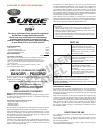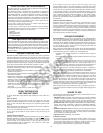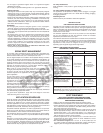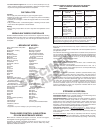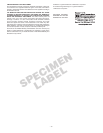
SPECIMEN
LABEL
– 2 –
A
GRICULTURAL USE REQUIREMENTS
U
se this product only in accordance with its labeling and with the Worker
Protection Standard, 40 CFR part 170.
T
his standard contains requirements for the protection of agricultural
workers on farms, forests, nurseries, and greenhouses, and handlers of
agricultural pesticides. It contains requirements for training, decontami-
nation, notification, and emergency assistance. It also contains specific
instructions and exceptions pertaining to the statements on this label
about personal protective equipment and restricted-entry interval. The
requirements in this box only apply to uses of this product that are
covered by the Worker Protection Standard.
Do not enter or allow worker entry into treated areas during the
restricted-entry interval (REI) of 48 hours.
For early entry to treated areas that is permitted under the Worker
Protection Standard and that involves contact with anything that has
b
een treated, such as plants, soil, or water, wear:
• Coveralls
• Waterproof gloves
• Shoes plus socks
• Protective eyewear
Non-Agricultural Use Requirements
The requirements in this box apply to uses of this product that are NOT
within the scope of the Worker Protection Standard for agricultural pesti-
cides (40 CFR Part 170).The WPS applies when this product is used to
p
roduce agricultural plants on farms, forests, nurseries, or greenhouses.
Reentry Statement: Do not allow people (other than applicator) or pets
o
n treatment area during application. Do not enter treatment area until
spray has dried.
PRODUCT DESCRIPTION
SURGE
®
Broadleaf Herbicide For Turf contains four active ingredients
including sulfentrazone that broaden the spectrum of weed control. These
combined herbicides provide limited residual activity at recommended
use rates. Sulfentrazone is in the aryl triazolinone family and inhibits
protoporphyrinogen oxidase (Protox), a pivotal enzyme in chlorophyll
production.Without this key enzyme, a build-up of peroxide-like compounds
occur, thus causing the plant cell membranes of weeds to rupture.
SURGE
®
Broadleaf Herbicide For Turf offers these advantages:
• Excellent postemergent activity with proven performance for broadleaf
weed control in turfgrass.
•
This product e
xhibits improved cool-weather performance compared to
standard “3-way amines”.
• High selectivity (turfgrass safety) in established cool-season turfgrass and
warm-season turfgrass.
• Sulfentrazone combinations provide rapid and effective weed control for
common and troublesome (tough) weed species in turfgrass, including:
dandelion, spurge, white clover and dollarweed (pennywort).
• The speed of action (rate of weed phytotoxicity) and the early weed
symptoms are features of sulfentrazone combinations compared to
standard “3-way amines”. Often, the weed injury symptoms can be noticed
within hours of the application and plant death can occur within
10-14 days.
•
This product is generally rainfast in as little as 6 hours.
SPRAY PREPARATION
AND TANK MIXTURES
In certain applications, liquid fertilizer may replace part of the water as a
diluent.
W
ater as diluent:
Add one-half the required amount of water to the spray tank, then add
SURGE
®
Broadleaf Herbicide F
or
T
urf slo
wly with agitation, and complete
filling the tank with water. Mix thoroughly and continue agitation while
spraying.
When this product is left standing for extended periods of time, re-agitate to
assure unif
ormity of the spray mixture.
Do not use tank additives that alter the pH of the spray solution below
pH 5 or above pH 8. Buffer the spray solution to alter the pH range as
appropriate.
Liquid fertilizers as diluents:
ALWAYS PREMIX SURGE
®
Broadleaf Herbicide For Turf WITH WATER
BEFORE ADDING TO FLUID FERTILIZERS.
For liquid nitrogen solutions
such as U.A.N. or urea solutions. use a premix of 1 part of this product with
4 parts of water or use a premix with a 1:4 ratio of product to water. For
other fluid fertilizers such as suspensions, use a premix of 1 part of this
product with 50 to 60 parts of water.
Use suitable sources and rates of fertilizer based upon local
recommendations. Refer to the mixing directions on the labels of the liquid
fertilizers.Always perform a jar test for compatibility before large scale mixing.
The jar test can be conducted by mixing all components in a small container
in proportionate quantities. If the mixture separates after standing and can
be mixed readily by shaking, then the mixture can be used and applied with
s
pray equipment providing continuous agitation. If large flakes, sludge,
gels or other precipitates form, or if a separate oily layer or oil globules
appear, then the herbicide and the liquid fertilizer should not be prepared as
a tank mixture.
Adjuvants and spray additives:
Adjuvants (such as surfactants, spreaders, spreader-stickers, spray
thickeners, foaming agents, activators, detergents, and drift reducing
agents) combined with this product can damage the leaf tissue of turfgrass.
If any discoloration or cosmetic effects are objectionable or would be
unacceptable, then adjuvant(s) combined with SURGE
®
Broadleaf
Herbicide For Turf would not be recommended. Do not use adjuvants and
spray additive tank-mix combinations, unless your experience indicates that
t
he tank mixture will not result in turf injury.
GROUND EQUIPMENT
S
pray distribution:
T
he accuracy and uniformity of the herbicide distribu-
tion is the sole responsibility of the applicator. Power sprayers fitted with a
boom or spray wand/gun may be used for broadcast applications and spot
treatments
. Boom sprayers equipped with appropriate flat fan nozzles, tips,
and screens are suitable for broadcast applications. For best spray distribu-
t
ion and coverage, select a spray volume and delivery system that will
ensure accurate and uniform coverage.
S
pray volumes of 20-220 gallons per acre with spray pressures adjusted to
between 20-40 psi. Use higher spray volumes for dense weed populations
(up to 220 gallons per acre or 5 gallons per 1,000 square feet).
• Calibration and proper application are essential when using this
product.
• Over-application or rates above those specified on this label can cause
turf injury.
• Hand-held technique: Wands fitted with flat fan nozzle tips may be
used with the appropriate technique. Flat fan nozzles should not be
waved in a back-and-forth motion, or in a side-to-side motion, or in a
swinging arm motion. Instead, the nozzle should be held stationary at
the proper height.Side-to-side motion results in uneven coverage.
Hand-operated sprayers including backpack sprayers, compression
sprayers, and knapsack sprayers are appropriate for small turfgrass areas
when po
wer equipment is unavailable, uneconomical, or impractical.
This product may cause injury to susceptible/non-target plants at the use
site by contacting the foliage, stems, or roots.To prevent injury to suscepti-
ble crops and other desirable broadleaf plants including but not limited
to cotton, legumes, tobacco, tomatoes, garden/vegetable crops, and
ornamentals (flowers, trees, and shrubs) avoid contact with the spray
solution, spr
ay droplets, and spray mist (fine droplets). Applications are
recommended only when there is no potential hazard from spra
y drift during
dormant and active growth periods. Do not apply when conditions are
conduciv
e to spr
a
y dr
ift from the use site to untreated areas.
After using this product, clean sprayer with soap or detergent and water, or
an approved spray tank cleaner and rinse thoroughly before applying other
pesticides.
WHERE TO USE
This product provides selective broadleaf control in warm-season and cool-
season turfg
r
ass in f
our (4) use sites.
•
Institutional sites are defined as turf areas around properties or facilities
providing a service to public or private organizations including, but not
limited to hospitals
, n
ursing homes
, schools
, m
useums
, libr
aries, sport
facilities, golf courses (fairways, aprons, and roughs), and office buildings.
•
Ornamental sites include turfgrass established around residences, parks,
streets, retail outlets, cemeteries, industrial and institutional buildings,
recreation areas, fairgrounds, areas adjacent to athletic fields and paved
areas.
•
Residential/domestic sites are defined as areas associated with the
household or home life including, but not limited to apartment complexes,
condominiums, and patient care areas of nursing homes, mental institu-
tions
, hospitals
, or con
v
alescent homes
.
•
Agricultural site: Commercial sod production.
Prohibitions of Sites:
•
Do not apply to an
y body of w
ater such as lak
es
, streams
, rivers, ponds,
reservoirs, or estuaries (salt water bays). Do not apply to any shorelines
(non-cropland sites adjacent to the edges of a body of water) for lakes,
streams, rivers, ponds, reservoirs, or estuaries (salt water bays).
• Do not apply to wetlands (swamps, bogs, potholes, or marshes).



